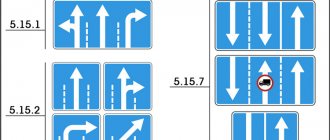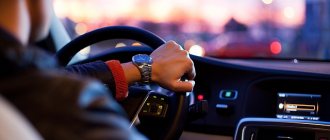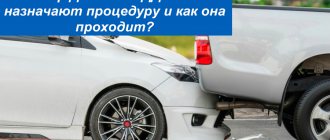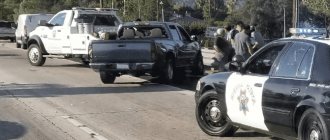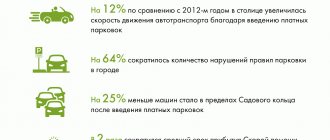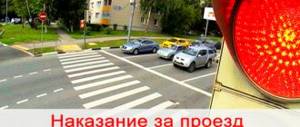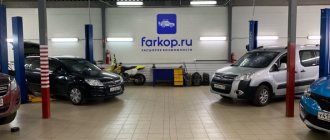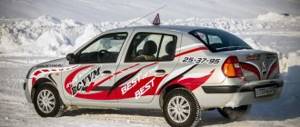To avoid causing an accident while driving at an intersection, drivers must adhere to existing traffic rules. Traffic through intersections is fully regulated by traffic rules.
The driver, approaching an intersection, must determine whether it is unregulated or regulated, since this determines how he should act.
Dear readers! The article talks about typical ways to resolve legal issues, but each case is individual. If you want to find out how to solve your particular problem , contact a consultant:
+7 (499) 938-81-90 (Moscow)
+7 (812) 467-32-77 (Saint Petersburg)
8 (800) 301-79-36 (Regions)
APPLICATIONS AND CALLS ARE ACCEPTED 24/7 and 7 days a week.
It's fast and FREE !
Of course, there are general rules for crossing both signalized and uncontrolled intersections.
At the same time, many drivers ask questions such as “An accident at an intersection when turning left, who is to blame” or “An accident when turning left outside an intersection, who is to blame,” etc.
Road accident concept
Surely every driver has an idea of what a traffic accident is and what its consequences may be. However, not every accident can be classified as a traffic accident, so we need an accurate definition. It can be found in clause 1.2 of the Traffic Regulations, Art. 2 Federal Law N 196-FZ, which is responsible for road safety, the Code of Administrative Offenses and the law on compulsory motor liability insurance.
An accident is an event involving a vehicle that occurs while driving on the road, resulting in injuries or deaths, damage to the vehicle and the cargo or structures it carries, or any other material damage.
Moreover, these “events” have their own classification, risk factors and different consequences. An accident must be recorded and documented according to the generally accepted procedure for road users and the traffic police.
How to determine who is at fault in an accident at an intersection
Disassembly after an accident is a fairly common occurrence. Everyone wants to prove that they are right in choosing the order of travel. Practice shows that it is especially difficult to identify who is to blame for an accident when turning left. True, there are often other options. But the State Traffic Inspectorate solves such problems, even if there are no video cameras. The one who violates the rules, which are described in detail in Art. 13 traffic rules.
When approaching an intersection, you need to take into account priority signs, rowing, markings and the presence of tram tracks. In addition, the following are considered general rules for competently negotiating an intersection:
- When turning (no matter in which direction), it is necessary to provide passage for pedestrians and passage for cyclists crossing the road.
- It is prohibited to enter an intersection with a congestion, which will certainly lead to a stop that will impede cross-vehicle flow.
On unregulated
At many of our intersections there is neither a traffic controller nor a traffic light. Often the latter does not work. In the rules, such road crossings are called unregulated. The culprit in an accident at this type of unequal intersection is determined by violation of priority signs.
The person at fault is considered to be driving on a secondary road and not allowing a vehicle to pass on the main road. The latter is not called that for nothing; it determines priority. If the main road changes direction, drivers are required to pass each other according to the rules for driving through equivalent intersections: if you see an obstacle on the right, stop, let them pass and drive calmly. The same principle works on secondary roads, even for trams.
When entering a circle, you must give way to all vehicles moving along it. When making a left turn/U-turn on an equivalent road, you should give way to all oncoming cars heading straight or to the right. This rule also applies to carriage drivers.
On adjustable
An intersection, the order of passage of which is determined by a traffic controller or a traffic light, is called a controlled intersection. When turning left/turning back at the permission signal, you also need to give way to oncoming vehicles moving straight or to the right. When moving along the arrow along with a yellow or red signal, you must let vehicles from other directions pass.
If a traffic light/regulator allows the movement of a tram and a car, then the former has priority. But on a switch with a red or yellow signal, the tram is also obliged to let vehicles from other directions pass.
The driver entering the intersection must complete the maneuver regardless of the signal. If, when turning in front of traffic lights, there are stop lines in the markings, you must obey the requirements of each of them. Even with a permitting signal, you are required to give way to vehicles and pedestrians who did not manage to complete their movement in a timely manner.
On unequal
On a secondary road, the driver must first always let those following on the main road pass, regardless of the direction of their movement. It's simple: I stopped, let it pass, then drove off myself.
You can tell which road is the main one by looking at the road signs and the quality of the surface. If there are no signs, and the quality of the surface cannot be visually determined (bad weather, visibility, etc.), you must assume that the road is of secondary importance.
On equivalent
At an unregulated equivalent intersection, the right-hand rule is used. The tram here enjoys an absolute advantage over other vehicles, regardless of the direction of travel.
Examples from judicial practice
In practice, there are a lot of trials in cases of traffic accidents at intersections. Below are some examples.
The incident occurred at a T-shaped intersection, at the intersection of Aristarkhovsky and Drovyanoy lanes in Moscow.
Three brands of cars were involved in the traffic accident at this equivalent intersection: Nissan, Chevrolet, and Citroen.
The accident occurred due to the lack of priority signs, as well as insufficient knowledge of one of the drivers.
Driving through the intersection was carried out in accordance with the “interference on the right” rule. It is necessary to consider who is to blame for this traffic accident.
The court took into account the fact that this accident was recorded by a video surveillance camera that was installed at a store located near the intersection.
This makes it easy to find out who is the culprit and who is the victim. It is worth noting that ignorance of traffic rules in this case led to the accident.
According to the facts established by the court, the driver of the Chevrolet car was obliged, in accordance with the traffic rules, to yield to the driver of the Nissan car as “interference on the right.”
However, breaking the rules, he drove straight ahead at high speed. As a result of this, a tangential collision occurred between Nissan and Chevrolet cars.
The Nissan vehicle had damage to the roof, both left doors, and the left front fender. The Chevrolet's right doors, rear fender and front bumper were damaged.
The third participant in the movement, a Citroen car, was also damaged due to changes as a result of the collision of other cars.
From the road accident diagram it is possible to determine the trajectory of vehicles:
After a call, traffic police inspectors arrived at the scene of the accident and determined that the driver of the Chevrolet was at fault for the accident, as he had violated traffic rules while crossing uncontrolled intersections.
The current traffic regulations stipulate that:
- the driver of a trackless vehicle at the intersection of equivalent roads must give way to cars approaching from the right;
- the driver of a trackless vehicle, when making a U-turn or turning left, must give way to vehicles that are moving from the opposite direction along an equivalent road to the right or straight;
- If the driver of a car due to circumstances (lack of priority signs, bad weather conditions) cannot determine which road he is on - a secondary or a main one, he must assume that he is on a secondary road and let other cars pass.
A similar decision was made by the court when considering the case. Accordingly, the culprit had to pay a fine for an accident at the intersection.
From the above we can conclude that the current legislation carefully regulates the order and rules of traffic at intersections.
All drivers must comply with them, otherwise the offender may be prosecuted or cause an accident.
In this case, he may become a participant in long legal proceedings both with the insurance company and with other participants in the traffic accident.
How to assess car damage after an accident is described in the article: assessing car damage after an accident. About mutual fault in an accident, see the page.
Find out what to do in case of a minor accident from this information.
Uncontrolled intersection: collision when turning left and overtaking
Driving through an uncontrolled intersection is more difficult, because no one gives instructions in what order to drive. Therefore, in case of accidents in such places, it is more often possible to find the fault of each participant in the accident.
In addition to observing the order (priority of passage), it is necessary to take into account the possibility of overtaking a vehicle coming from behind. Overtaking is definitely prohibited at controlled intersections, but not always at unregulated intersections. In clause 11.4 of the traffic rules it is noted that overtaking is not allowed only on a secondary road and pedestrian crossings.
The fault of the driver making the turn
Any change in the direction of movement of the vehicle must be indicated by turn signals (Section 8.1 of the Traffic Regulations). If there are several lanes, the driver who sees another car on the right turning left must let it pass.
Before turning left, the driver must assess the situation and make sure that other cars behind and to the left will not interfere with him. If these conditions are not met, he will be found guilty in an accident.
The overtaking driver's fault
Even passing from the left lane often causes collisions with cars turning left at uncontrolled intersections, although overtaking is not prohibited here. Article 11.2 of the traffic rules states that overtaking is prohibited when the car in front has already turned left. If this is not noticed in time, the State Traffic Inspectorate will decide the issue not in favor of the “racer”. But traffic rules also prohibit preventing overtaking by increasing speed and so on. If the turning driver is caught doing something like this, he will be found guilty.
Collision with the rear side of the vehicle.
The place where the force is applied is located near the rear end of the car on the right. The car rotates around a vertical axis clockwise. There is a skid mark on the road from the rear wheels of the vehicle being hit. At the site of the collision there is crumbling paint, dirt, sometimes broken and torn parts of the car being struck, fragments of glass from the brake light, headlights and sidelights of the car being hit, fragments of the windshield of the car being hit with a wagon body layout, glass from the rear door or rear window in a collision with a passenger car. . The front surface of the striking vehicle and the rear surface of the striking vehicle are directed in the direction of movement of the striking vehicle.
The side surface of the car being hit is concave or destroyed depending on the make of vehicle, the B and rear pillars are bent or torn, the glass is broken, the rear bumper is bent and torn off, the trunk or hood lid is deformed. The door opposite the impact has a concavity and sometimes blood and hair, its glass is broken The victims are in their places.
The mechanism of injury, nature and location of damage caused by a right-hand collision are similar to those in cases of collision with the front of a car hit from the left.
| Next > |
Controlled intersection: accident when turning left and overtaking
Even at a controlled intersection, you can get an unexpected side impact when turning left.
Driver's fault when overtaking
Overtaking at a signalized intersection is prohibited. Therefore, the driver of the overtaking car is found guilty.
Driver's fault when turning left
If the traffic light/traffic signal allowed the maneuver, the left turn signal was on, there were no obstacles on the left, the culprit is the driver who turned into the wrong lane (multi-lane road) or tried to overtake. If some rules were not followed by each participant in the accident, you will have to figure out who is more to blame. Logically, this is the first person to commit wrong actions and violate traffic rules.
Turn left: controversial situations
As is already clear, road accidents when overtaking and turning left at intersections are caused by a series of mistakes and violations of the rules committed by all its participants. This is where controversial issues arise. A simple example: a car intends to turn left on a yellow signal and has even started the maneuver, but the driver of the oncoming car ignored this and drove into his right side. Who will be guilty?
On the one hand, the first driver, because he did not let oncoming traffic pass. But on the other hand, he started his maneuver earlier, and the oncoming car could have started moving on a yellow rather than a green signal. This is where you have to prove your case to every driver. Almost everything is taken into account:
- traffic light markings and operation;
- the distance from the oncoming car to the intersection at the moment of starting movement;
- speed of both cars;
- the ability to apply emergency braking;
- whether the turn signal was turned on.
Testimony of witnesses (eyewitnesses), recordings of video recorders and surveillance cameras will help the traffic police inspector to correctly assess the situation. If the protocol does not satisfy one of the drivers, a department commission or even a court will decide who is guilty in a particular situation.
At a T-junction, when turning left from a secondary road onto the main road, a situation may also arise where both drivers are at fault. Suppose the first one arrived, stopped, turned on the turn signal, looked around and began to turn, but at that moment a car moving on the right crashes into him. The first one is guilty because he did not make sure that there was no obstacle or did not estimate the speed. The second one was driving too fast and either did not see or did not have time to brake. It is very difficult to determine who is right and who is wrong.
When leaving the side of the road, we actually make a left turn. And this is where disputes often arise. The driver leaving is obliged to turn on the turn signal and make sure there are no obstacles, and the driver moving along the road is obliged to let it pass or take all measures to prevent a collision.
Accident with an overtaking car
Let's consider a more complex situation:
So, the driver of the orange car drives onto the main road. At the same time, he made sure that the cars on the left were at a distance sufficient to complete the maneuver. However, when entering the intersection, a collision occurs with a minibus, which begins to overtake in front of an uncontrolled intersection.
At first glance, it seems that the driver of the orange car could not have predicted such a development of events. However, the red minibus overtakes in compliance with the rules. Those. the culprit of the collision is the driver of the orange car (clause 13.9 of the traffic rules, discussed above).
How to avoid such an accident:
- The driver of an orange car must know that such a development of events is possible and be prepared for it. If you have studied the above diagram, then it will not be a surprise for you when another car enters the oncoming traffic.
- When turning right, the driver of an orange car must look not only to the left (at the white car), but also to the right. Those. You need to make a turn while controlling the situation from all sides. As a rule, the cause of an accident is that the driver enters the main road, but looks to the left (through the window).
- The minibus driver should simply refuse to overtake at the intersection. In this case, the accident is not his fault, but he will have to spend a lot of time on paperwork and car repairs. In practice, it is better to avoid an accident completely than to be innocent of it.
What to do after an accident
A detailed algorithm for the driver’s actions immediately after an accident is indicated in the traffic rules in the responsibilities section. It is clear that you cannot leave. You need to stop, turn on the emergency lights, set the triangle, and then assess the situation. If there are victims, provide first aid or take them to hospital. Then you need to call the traffic police, record the location of the cars and clear the roadway if possible.
Then you can look for eyewitnesses and inform the insurance company. Read about whether a certificate and notification of an accident are required.
